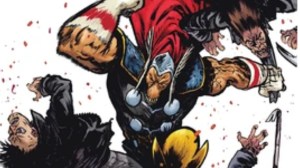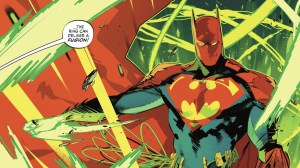Dynamite Entertainment has provided ComicBook.com with an exclusive look at the process art for Shadow/Batman #1 from writer Steve Orlando and artist Giovanni Timpano.
Videos by ComicBook.com
Through seven interior pages in layout, ink, pencil, and color, fans can follow along and trace Timpano’s process — and by doing so, if you’re fairly new to this, get a sense for how comic book art is composed, from the first layout sketches to the fully-colored version ready to be scripted/lettered.
“I was working on the finale of the second arc of Eclipse when Dynamite Executive Editor Joseph Rybandt emailed me, asking if I was interested in working again on The Shadow,” Timpano said in a statement. “I have to admit that I was a bit doubtful, because I drew several stories of The Shadow, with several writers, so I was wondering if I would have been able to add something new and different from the previous times. I’m that type of artist who always needs a challenge, who doesn’t like to repeat himself. Then Joe told me that it was not just The Shadow, but The Shadow/Batman. And later, once I read Steve Orlando’s idea for the story, all of my doubts vanished. We all know how important The Shadow was for Batman’s creation back in the day, and Steve have taken this connection between the two characters and transformed it into the very heart of his story. This is not a simple crossover between these two heroes, this is an important piece for both characters’ history. That’s why it was impossible to say no to this project. All this gave me a different incentive to add something new to my take on The Shadow. Basically, this is my third time on The Shadow, and I feel as I’m finding my definitive version of the character.”
This is not the first team-up of the pair — DC recently published Batman/The Shadow — but Dynamite will bring The Shadow/Batman to life in October, and once again bring two of comics’ most iconic characters together to save the world in a new, six-issue crossover event.
Writer Steve Orlando is joined by artist Giovanni Timpano, whose art we will use as a guide through the world of the series and the process of putting together a compelling comic book page.
THe Shadow/Batman #1 is due in stores on October 4.
LAYOUTS
At the layout stage, the artist puts together a basic page composition, deals with lighting, posing, and lettering issues, and otherwise creates a rough draft of the page so that they haven’t put an absurd amount of time into something that will create a bad surprise down the line.
In these pages, you can see that the fairly detailed breakdowns are numbered, presumably for lettering reasons since there are three numbers in the first panel so it clearly is not based on writer Steve Orlando’s panel descriptions.
Because of the color scheme of The Shadow himself, some of these layouts become their own mini works of art, with the red elements of his costume design the only other color represented on the page besides the stark blacks and whites of the layout ink and the paper itself.
The splash page — page 10 — is a particularly notable example since Dynamite provided ComicBook.com with the layout alone, while every other page they gave us a look at the full process.
The fact that the layout provides such a clear idea for where the eventual page will end up makes it a valuable addition to this preview without necessarily needing anything else to compare it to.
For the rest of the pages, though, next we move on to the pencils…






PENCILS
From a distance, pencils can look less “finished” than layouts, but if you look closely, there is significantly more detail in these pages than in the previous set of images.
Part of that comes from the fact that while layouts are meant to approximate the final look of the (black and white) page, pencils serve a different purpose and there is significantly more “white” space, giving the inker and colorist more room to breathe and the penciler more opportunities to make changes without a ton of erasure or White-Out.
The tightening up of the details mostly happens here, though, with all the little touches being added that were not significant enough to make the grade for the page layouts. Notice, for instance, the leaves floating between panels, crossing over the gutters to do so, on the cemetery page.
The pencils are both the fundamental base the the artist will build on to construct the final page and, in some ways, the part of the process that looks the least like a finalized comic book page.
Some writer-artists, such as Savage Dragon‘s Erik Larsen, will more or less start with pencils rather than working from layouts, as doing so gives them the opportunity to course-correct more quickly without having to alter every panel that comes after it.
On the other hand, some pencilers work from much looser pencils than this, giving the inker more leeway to determine the look and feel of the page without running the risk of spending time drawing something that will be overwhelmed by the inks and colors.





INKS
If you are a buyer of original art, the inked-but-not-colored pages are by and large what you are going to take home for your money.
At this point, the page clearly resembles a publishable comic book page, although particularly in a noir-tinged book like The Shadow/Batman, you can expec tthe colors to significantly alter the look and feel fo the page.
With many mainstream superhero comics, the colors share a kind of uniform feeling, defined by the needs of the ongoing series or the shared universe a character inhabits.
That means you could look at an inked comic book page and more or less know what its final, published version will look like. That is somewhat less true with a book like this, where Timpano has a very particular look and feel he is working with.
To the layman, pages like this provide a lot of insight into the process: the different widths of each of the many lines tend to suggest that the India ink was applied with a different brush or technique, putting lie to the old Kevin Smith joke that inkers are basically just “tracers.”
In the case of tight pencils like this, an artist who inks himself is the most likely to come out with pages like the ones you see below — where very little changes between the pencils and inks other than to create lighting, depth, and texture and to prepare it for the presses.





COLORS
Finally, the color phase.
At this point, the pages are completed as far as Timpano is concerned, and ready to be lettered.
Depending on the process, company policy, and other variables, this might be the point where the script is tightened up — although many corporate comics, and particularly a crossover like this where there are numerous sets of eyes on the thing before it ever sees the light of day — would likely require a finalized script to be approved by editorial before the art is locked.
The colors in any Batman comic, but particularly one like this or the recent Batman/Teenage Mutant Ninja Turtles crossover, tend to help shape the identity of the book. Just how superheroic should it be, versus how much of it is a detective/noir story? The colors will help to tell that story almost as much as the script.
You can also see below how the subdued colors on the “burial” page help to inform the storytelling and the mood of the larger comic, but the muted red of The Shadow’s tie makes the individual page feel less like a piece of pop art than it did when the bold red of the layout marker was clashing against the crisp black and white of Timpano’s first run at the page.





Coming soon…
The Shadow/Batman #1 is due out in October, which means you want to reach out to your retailer to make sure you get a copy.
Final Order Cutoff comes in September, and with 8 different covers to choose from, make sure you look carefully at the solicitation text (seen below) to tell your retailer which one you want.
The World’s Greatest Mystery. The World’s Greatest Detective. They can barely stand each other, so how will they possibly deal with the World’s Greatest Evil? What legacy can two of the world’s most enduring icons of justice leave once they discover an ancient evil has been living inside the world they protect for centuries, attached to its heart. Can Batman and the Shadow save the world without killing it in the process?
Writer Steve Orlando (Batman/The Shadow, Justice League of America) and artist by Giovanni Timpano (The Shadow, Transformers) unite to tell an instantly classic tale of noir, mortality and generational heroes and villains.
Price: $3.99
Shipping: October, 2017
SKU: C72513026213401011
Rating: Teen +
Cover A: David Finch
UPC: 725130262134 01011
Cover B: Ethan Van Sciver
UPC: 725130262134 01021
Cover C: Alex Ross
UPC: 725130262134 01031
Cover D: Dustin Nguyen
UPC: 725130262134 01041
Cover E: Brandon Peterson
UPC: 725130262134 01051
Cover F: Bill Sienkiewicz
UPC: 725130262134 01061
Cover G: Howard Porter
UPC: 725130262134 01071
Cover H Subscription: Giovanni Timpano
UPC: 725130262134 01081
Writer: Steve Orlando
Art: Giovanni Timpano
Genre: Superhero
Publication Date: October 2017
Format: Comic Book
Page Count: 32 Pages
ON SALE DATE: 10/4








